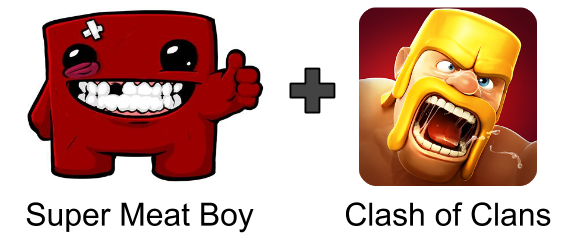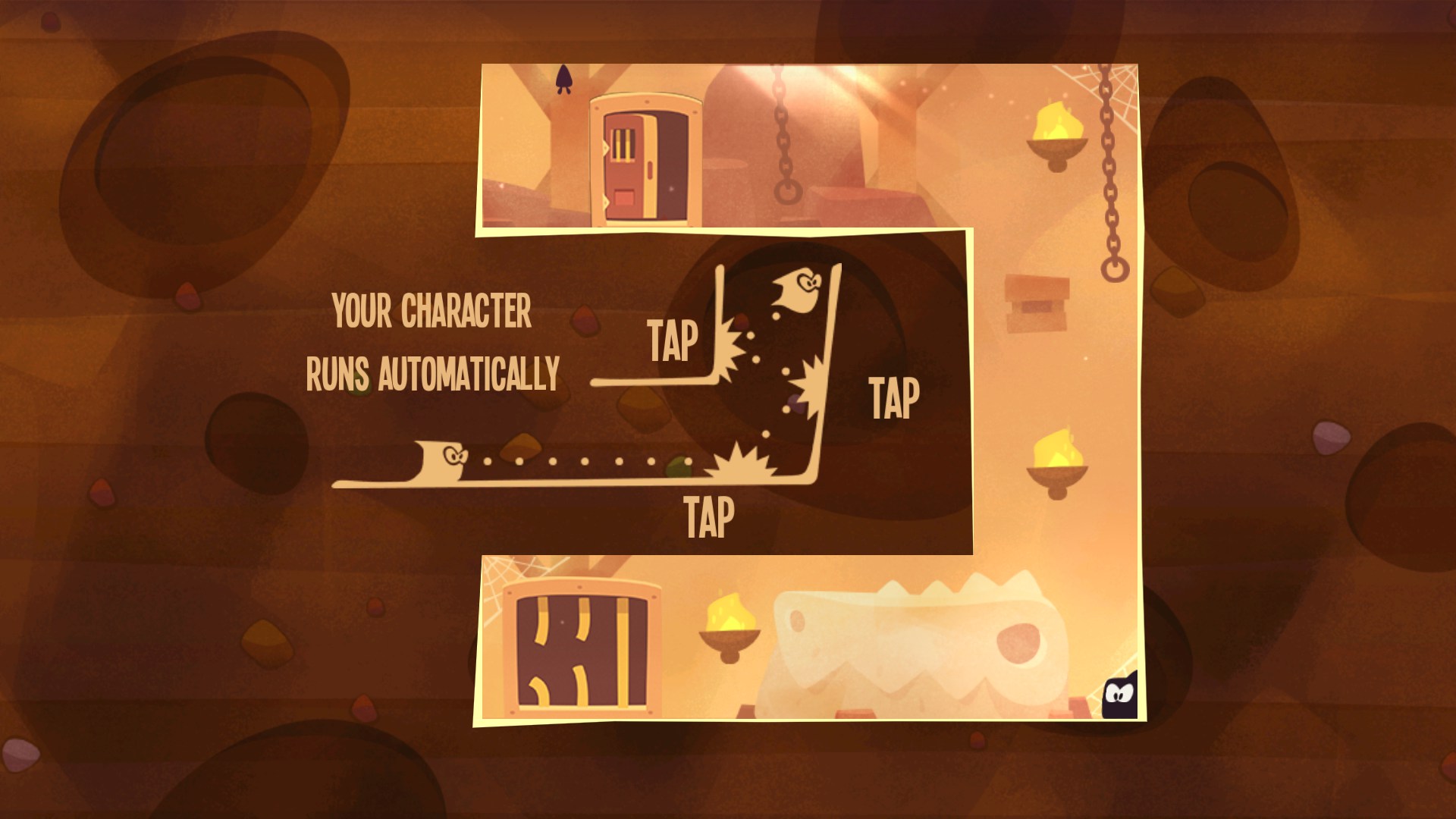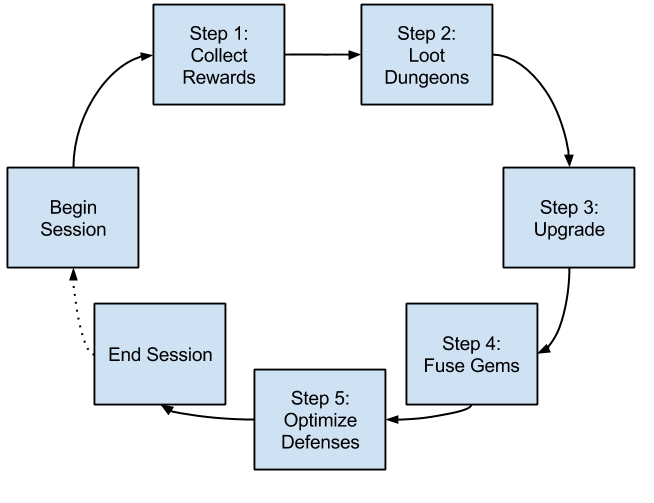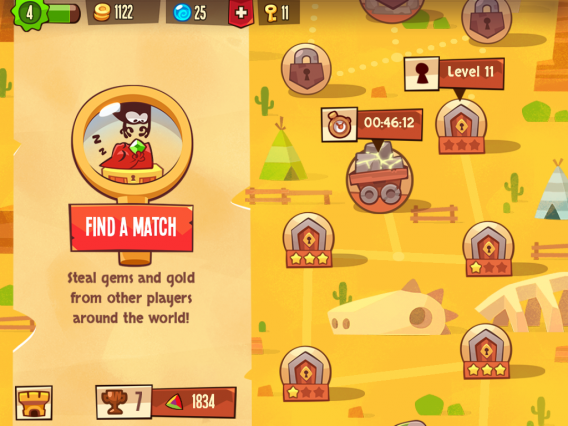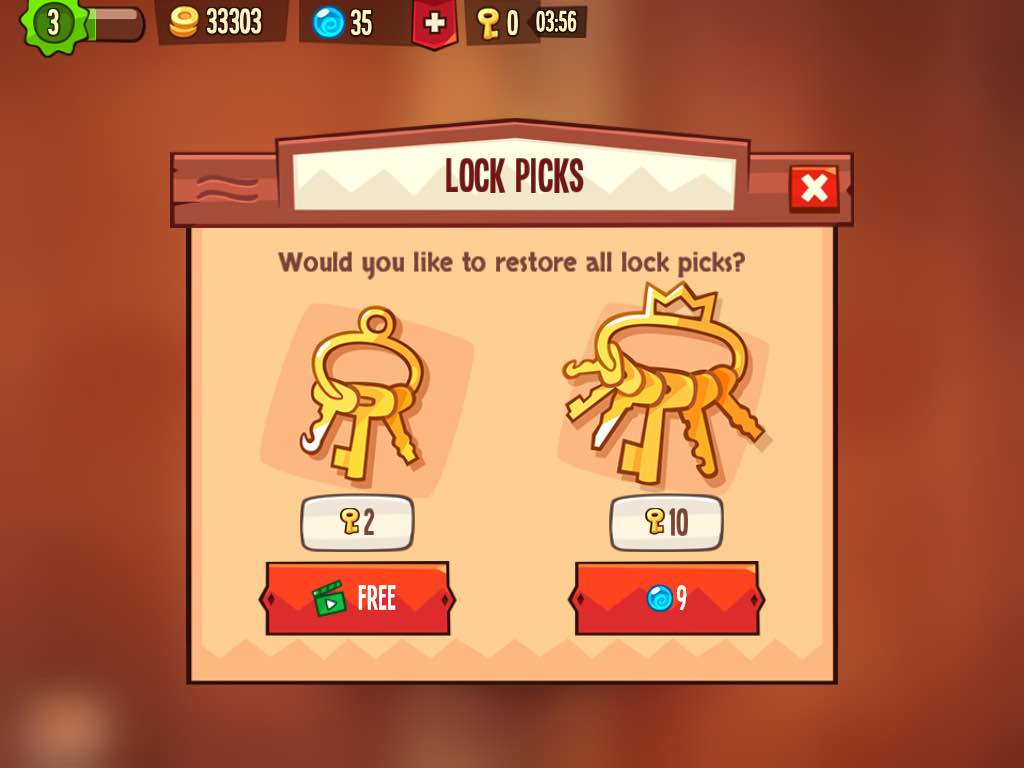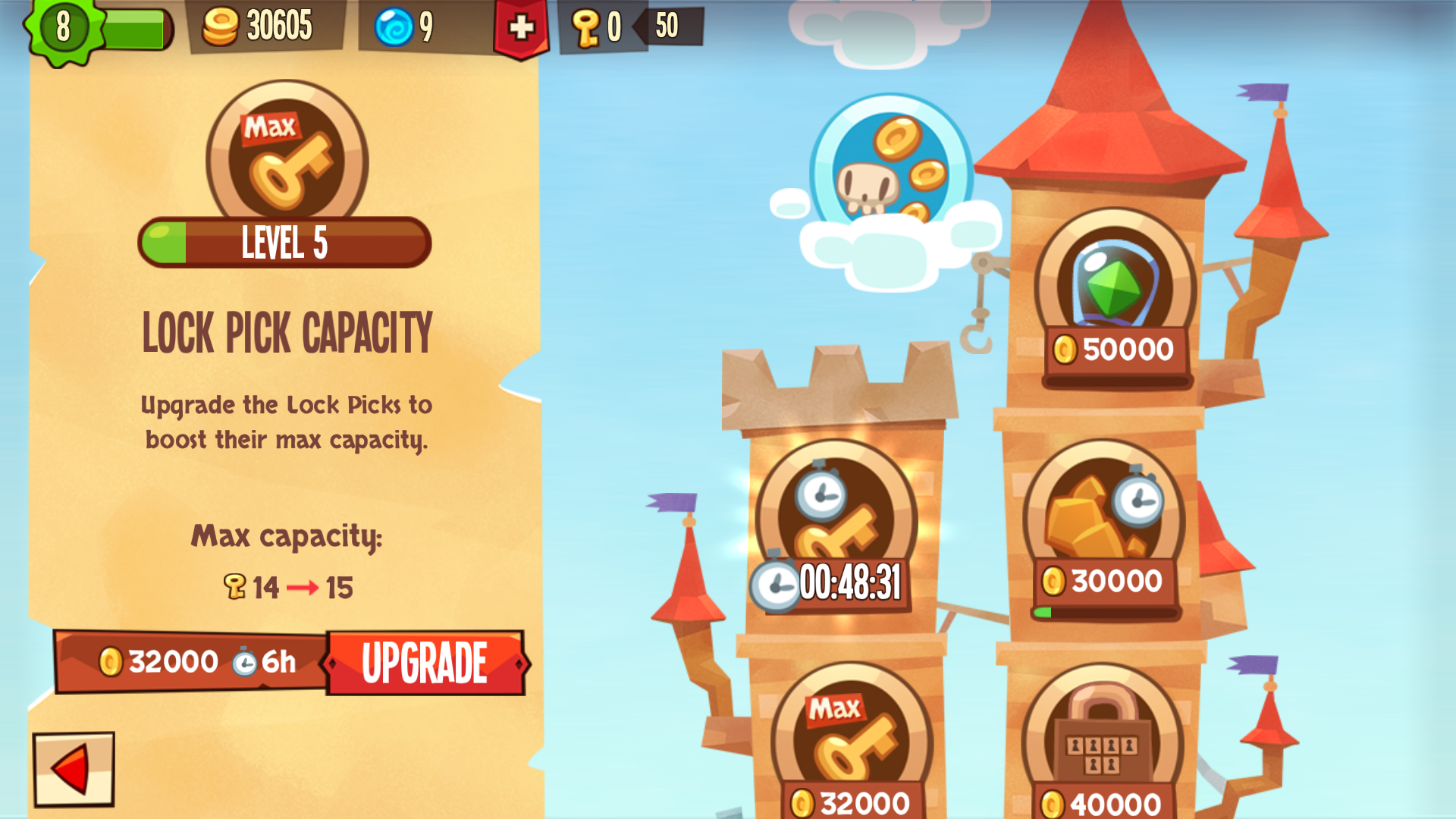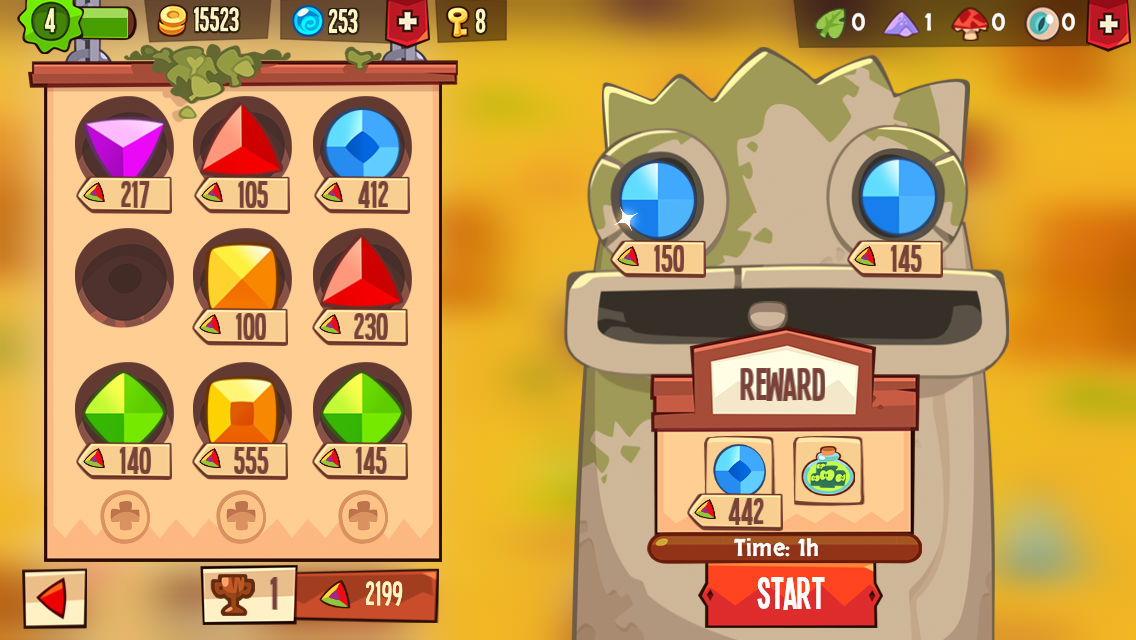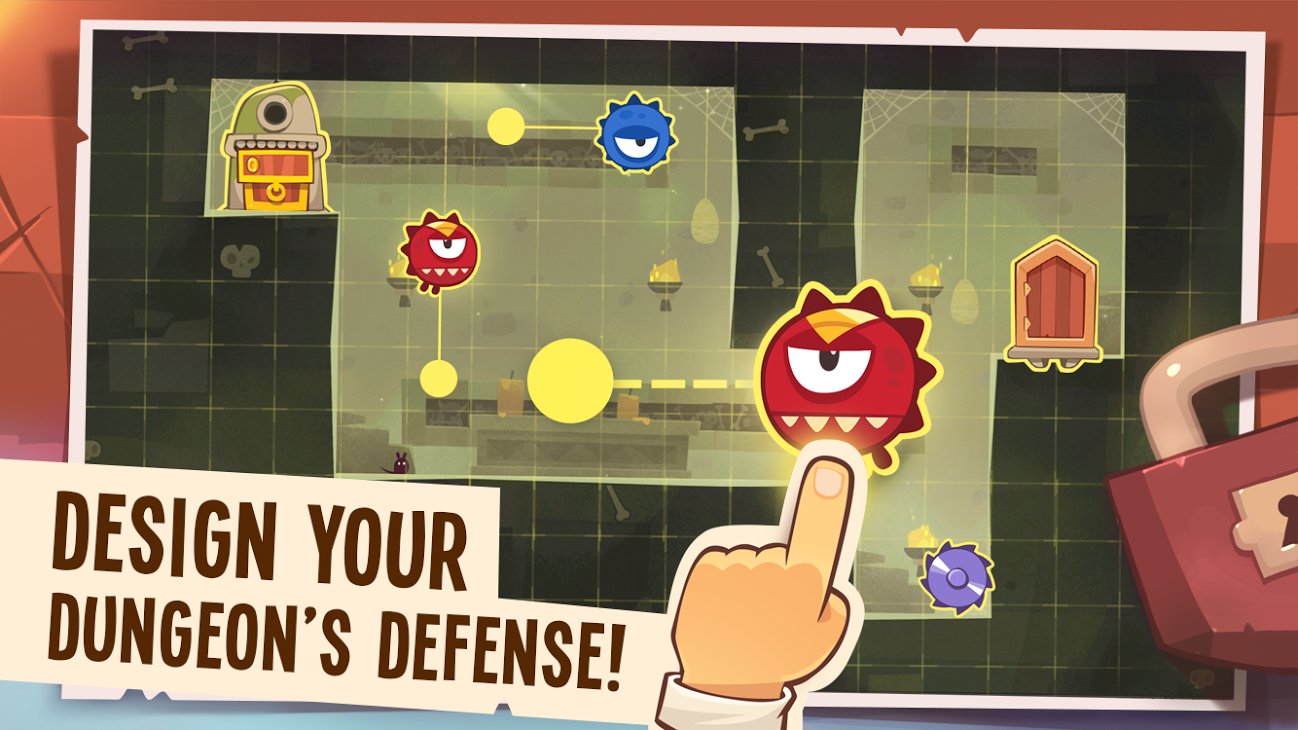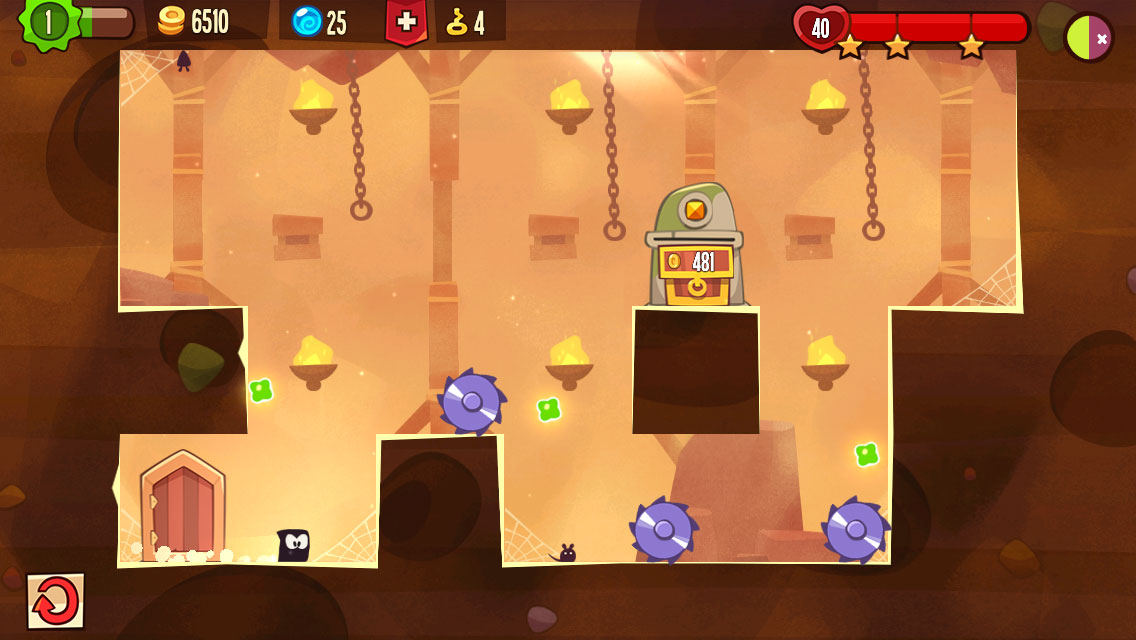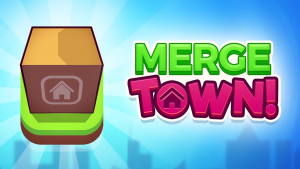Deconstructing King of Thieves
Let’s take a deep dive into ZeptoLab’s latest game King of Thieves. Launched in February 2015, this game has piqued my interest. While not on the top spot yet, the game’s bold design deserves a look.
In my opinion, this is a game that deserves to be successful. It feels unique and has all the elements that make up a top grossing game. ZeptoLab has taken what works in simulation and strategy games, and applies this to a totally new genre and a completely new target audience.
This approach is what I feel more new game designs should do to be successful on the AppStore.
The Pitch
The pitch for King of Thieves is “Super Meat Boy” combined with “Clash of Clans”.
The core gameplay is a one-button platformer. Your Thief (the little cute black shadow) automatically runs left or right. You can tap to trigger a jump in the current direction. You can also jump off walls to reverse the players direction. ZeptoLab has managed to give classic platformers a mobile makeover. With one-touch controls it feels native on mobile. With simple rules, it feels expressive and gives players plenty of options. The gameplay is simple and is very transparent about what you did wrong each time you die. This creates very addictive core gameplay.
The object of each level is to reach a treasure chest. Go from “point a” to “point b” by avoiding traps. Hitting a trap will reset your progress right to the beginning. This punishment gives the game the “Super Meat Boy feel”. Reasons for losing are always clear to the player, and there is very little friction to restarting. The player jumps back into the action as soon as they are killed, making it extremely addictive to just keep trying to beat a level.
The meta (the progression systems outside of the core platformer gameplay) is a re-hash of Clash of Clans. They’ve managed to modify the standard Clash of Clans formula into something that works very well with the core platformer gameplay. Just like Clash of Clans, King of Thieves asks the players to manage two layers of gameplay: attacking and defence. On attack, the player plays platformer style levels to steal gold and gems (more on this later). On defense, the player must design a base that defends against other players’ attacks. Players sessions are focused on stealing as much loot from players around the world to upgrade their own abilities.
The Session Loop
To deconstruct, I’d like to focus on session design. To do this, we need to break down the game into its daily action loop: the repetitive actions the player takes to progress in the game. Let’s evaluate each step in regards to how it impacts the way the sessions feel.
Looking back at the post on Flexible Sessions, the key principle of designing sessions is about creating a diminishing curve of value for sessions per day and for session length. Just to reiterate: The first rule is that the first session of the day should feel more impactful than the 2nd, 3rd, or 4th time the player returns. By the 5th+ session, this should give minimal value to the player. The second rule is that session length should also have a diminishing curve of value. Eventually a player should naturally feel that returning at a later point in the day would be more beneficial. These two rules make up strong session design.
So how does King of Thieves execute this?
Step 1: Collect Base Rewards
Each day the player begins their session with collecting the rewards from their dungeon:
- Collect gold from their stash. (Optional Short Timer)
This is a bucket-filling mechanic. Allowing players to collect from the stash as many times as they wish throughout the day. - Collect gold from successful defences. (Short Timer)
Making sure players feel good about their defences, players collect gold for every failed attempt by other players in their dungeon. While not a lot of gold, this certainly feels good when you’ve come back after a long absence - Collect generated gems (Long Timer)
Gems generate on the map on a longer cycle (multiple hours).
You can see here that these three reward cycles each have varied timer length, which allows for strong session design. Short timers to value coming back more per day, but longer timers to reward daily play. Using rewards of varying length, the player has a clear diminishing value for returning multiple times throughout the day.
Step 2: Loot Dungeons with Keys
After the player has collected all their rewards, they want to maximize their cash for their current session. There is always the threat that other players in the world will steal any resources they have when they leave the game.
To do this, players loot other player’s dungeons (PvP levels) or designer-created levels in a map (PvE levels). Player-created levels hold high value gems. Whereas the PvE levels have higher gold rewards (sometimes), unlock new gem generating mines and new dungeons which the player can move to. This system works because both PvE and PvP benefit the player in different ways.
King of Thieves innovates with their pacing mechanics. Instead of using energy or lives like in most games, they use “Keys”. Keys refill like in most games with time. The key difference is that the amount of energy (or keys) the player needs to spend to enter a level is randomized.
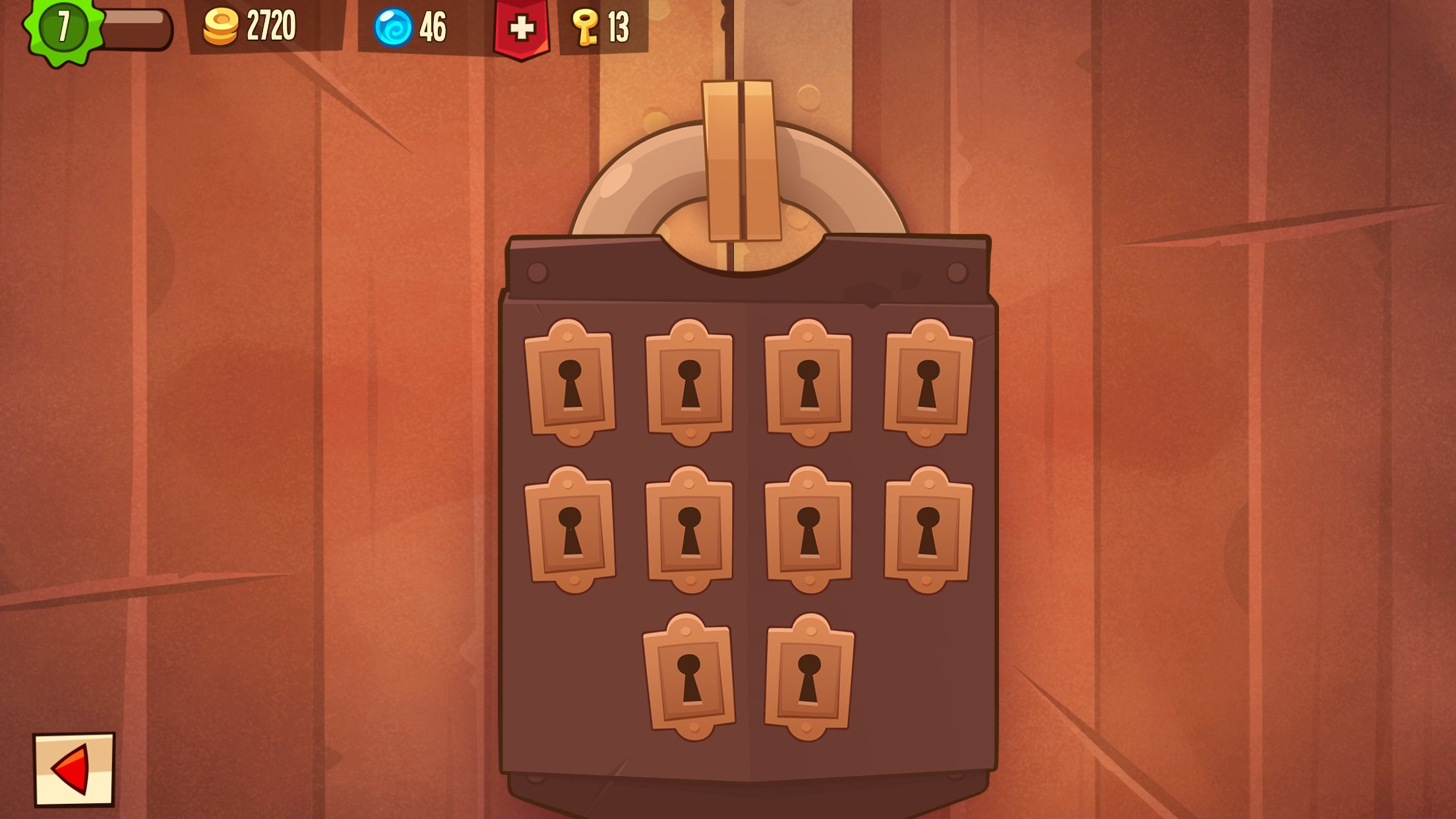
Players can choose a lock. Each attempt costs a key. Only one of them gains entry. Randomized Energy.
The player chooses locks on a screen with their keys. If they get the right key, they enter the level. If they choose the wrong one, they must spend another key. The game supplies the player with more than the usual amount of energy (10+). However, some levels can use 1 key to enter, others up to 15 keys to enter. Why would ZeptoLab design a system like this?
This system doesn’t please all player types. I’m convinced ZeptoLab benefits more from this system than the player experience. Not an easy choice I’m sure as a designer, but these sacrifices are sometimes necessary in a free to play game.
From the onset, this system feels arbitrary, just like an energy system. The player’s ability to loot is capped by some tacked on economy. Compared to Clash of Clans, Clash’s pacing mechanics make sense: you will eventually run out of troops to loot opponents. King of Thieves just says you run out of “keys”. Could this be fixed if the player had to “craft” keys in their base? Could this be fixed if the player had to build clones of their shadow player to start looting? Maybe. Overall I’m not a fan of the system, but I understand the benefits for ZeptoLab.
Because the system is randomized, players can try for one more level even if the player only has 1 or 2 more keys left. If they get lucky, this feels great. They get to play the level with little cost. If they fail, they are presented with this screen:
This screen is a high conversion screen for their video ads. Want to keep trying? Watch a video ad. Video ad revenue is becoming more and more interesting in the mobile free to play space, and I completely understand why ZeptoLab wanted to create a pinch point for this type of system. Players then binge watch some videos to get in that “just one more play” feeling.
On top of converting players with video ads, this type of randomized energy system also creates a nice way to balance harder and harder levels. Players can upgrade their key storage limit to be able to reach higher and higher levels. The higher the level, the more locks that the player must attempt. Also, this can create an interesting session per day value curve. ZeptoLab can use metrics like sessions per day and session length in their decision about how lucky the player is. This may be dubious, but this type of “invisible hand” to guide the session design can be very powerful.
In the end, I’m unsure if this system of randomized keys was the best choice for King of Thieves. The system is a unique design and I’m excited to see what the market thinks of it. Just based on the conversion to video ads, I think this could be something to try for other genres.
Step 3: Upgrade Your Base (or Else!)
After the player has looted as many dungeons as they could in that session, they may use their found coins to upgrade their dungeon and resource generation. Any coins left over will most likely be stolen, so players attempt to spend every coin they looted. This promotes going for one more looting session, or extending the session to purchase more gold.
Step 4: Fuse Gems
The key to the meta and progression of the game is fusing of gems. Players collect gems from mines on the world map and by looting other players in the world. The player then takes the gems collected and fuses them in their base.
Fusing usually takes many hours (3+ hours for a usual gem). During this time the gems in this fusing ritual are open for stealing by other players. This is the most anxiety-inducing timer in the game. A gem will be stolen unless they keep the game open or have amazing defences. I spent about two hours on a weekend keeping the game open while watching movies because I was too afraid to close the app and lose my gems.
So why would players opt-in to this nerve wrecking timer?
Increasing gem value is the goal of King of Thieves. The total value of your gems is how you rank in the game. Players are looking to retain only the highest quality gems (which is shown by a number). However, there are only limited slots the player can have to hold onto gems. So players quickly run out of slots and are forced to fuse gems together to make more slots for higher level gems.
This was a very, very smart design choice by ZeptoLab. This creates a natural cap for progression and creates a lot of very interesting choices for the player. It also creates an obvious high conversion item for monetization: the extra slots for gems. Similar to the builder in Clash of Clans, ZeptoLab has created a high conversion item out of these extra slots. I’m convinced that if they brought this to the forefront and made it cheaper for first time players, this could be a strong conversion item.
Step 5: Optimize Defences
After they’ve completed this loop: collect, attack, upgrade, fuse… what’s left?
Just like in Clash of Clans, players can extend their sessions by optimizing their dungeons defence layout and adjust the positions of traps. This comes with one caveat: the player must be able to beat their own level twice… in a row.
This definitely creates a session extension. I’ve spent well over a half an hour trying to create the optimal dungeon design. All this time was not incentivized by the game, but I wanted the best layout possible. This is exactly what you want to create in your session design. A session extender that players can take as little or as much time with as they wish. The value diminishes over time.
What King of Thieves did right: Social Pressure Mechanics
ZeptoLab shows an excellent example of how to add effective social mechanics to a game. Asking players for help to retrieve lost gems creates social pressure. I feel good about helping my friends, I enjoy when my friends help me out when I’m less active. I rely on my friends to help me optimize my fusing timers. The value of having active friends is apparent.
The league system creates a nice PvP environment with a clear reason to collect gems. Instead of feeling like I’m levelling up just based on some arbitrary number the designer has created for me (ex. collect 5000 gem value in 5 days), I’m competing against a living breathing opponent. I have to be engaged to compete, and the number is always growing so I never feel safe about my position. Sometimes I wish there were ways to specifically steal from other players on the leaderboard you were competing in. This would really drive up the competition.
King of Thieves also uses the same idea of clans in Clash of Clans. King of Thieves wants you to join a Guild. While the system is clearly in its infancy, it shows a commitment by ZeptoLab to the future of the game. Guilds are what will really drive the long term retention, and including it in the global launch was important. The mechanics at this point are still too early, but in the coming months I expect that ZeptoLab will build from this base and make very competitive play between Guilds stealing gems from each other. I hope they find a way that Guild members can work together on a dungeon or a raid. It would also be interesting to incentivize Guilds to put their most valuable gems in a vulnerable position. This will really drive competitive gameplay between the Guilds and give a collective goal.
What King of Thieves could improve: Hardcore Skill
In the translation of the Clash of Clans metagame to Super Meat Boy style mechanics, something fundamental was lost. Because platformer gameplay is inherently so skill-based, the translation still feels like a massive amount of skill is required to win.
Clash of Clans (as discussed before) although it requires some mix of stats and skill, the main determinate to win each fight is Stats. If you have an amazing army, you are going to win. If you have spent a ton of time (or money), you will be able to dominate against an opponent lower than you. As you defeat more of these easier players, you will be matched higher and higher in the leaderboards. This will demand more skill, but mostly more stats. This system allows players to “hover” around matchmade opponents that challenge their skill level, but still require high stats. Even if I’m terrible at selecting where my troops go, I’m still progressing, and I may be lower on the leaderboard compared to other players at my stat-level, but I still am progressing.
King of Thieves is never flexible over the amount of skill it requires from players. As you progress in the game, it keeps demanding more and more skill from its player base. As a result, the game feels very hardcore. The players that reach the end game are a smaller and smaller niche of highly skilled players. Why does this happen?
As the game progresses, players slowly get harder and harder obstacles they can place in their dungeon. In order to set up a dungeon that is difficult, the player has to beat it themselves. As a result of this system, unless a player is highly skilled, their dungeon, regardless of the defences, will remain at the same low level of skill-difficulty. There is no way for a player to increase their defence without actually being far better at the platforming game.
There are some stats that affect the game: the damage of the obstacles, your shadow’s equipment and armour, the amount of keys you have, etc. But these stats clearly take less of a precedence over the skill. In my opinion, there are some levels that you just need high skill. So as you progress in the game, no matter how much time or money you’ve put into the game, you will reach levels that it doesn’t have an impact if you don’t have the skill. There is no “hovering” in the matchmaking that allows players to feel progress regardless of skill. Players with low skill will feel it: they are punished by losing levels very often.
This is most likely an artifact of trying to combine a high-skill genre (Super Meat Boy) with Clash of Clans. While this pushes away players that are expecting a lower skill level, I think it also engages the highly skilled players even more. The tradeoff between a highly engaged niche target audience and a flexible broad audience appeal is incredibly difficult to get right.
The Results:
On launch, the app was featured by Apple. This drove hundreds of thousands of downloads, but has yet to crack the Top 100 US Grossing. Can it get there? This will be an extremely tough. After a featuring, the only way to drive the necessary volume to reach the Top Grossing Chart is to purchase installs. This is extremely costly.
However, the game supports very strong early day retention and with more work can improve their long term retention. With continual improvements, this game has a chance to reach a stable position in the Top 250 Grossing.
Personally, I’m cheering for ZeptoLab. This design is refreshing. I had the feeling that the mobile free to play space is even more risk-averse than the console/pc space. This feels like a step in the right direction. This is a game ZeptoLab should be proud to have worked on. I hope other game developers can look at this example on how to innovate in new genres



